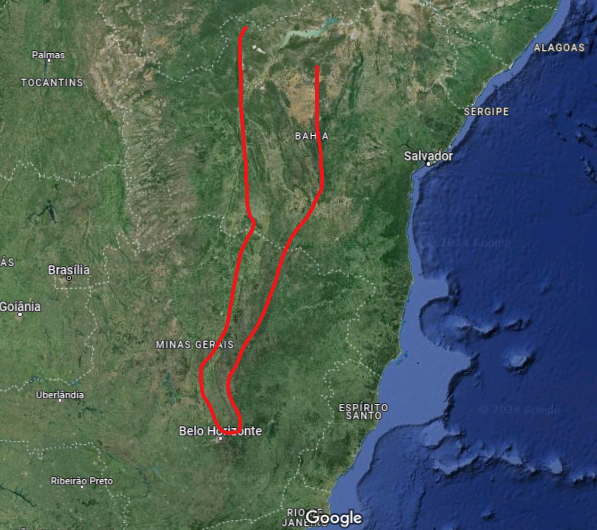Geology of Chapada Diamantina
What is Chapada Diamantina?
Chapada Diamantina National Park is located in the central region of Bahia, between 4 cities: Andaraí, Lençóis, Mucugê, and Palmeiras. However, its identifying region encompasses about 24 cities around the National Park (there may be more depending on which geographic aspects we consider). If we observe a map of Bahia, we’ll see a kind of “ridge,” like a column, where Chapada extends from north to south (Photo 1). By increasing the map’s perception distance, we’ll see that this ridge extends to the central region of Minas Gerais, with a “small gap” at the border between the states (Photo 2). This formation we see from northern Bahia to Belo Horizonte is the Espinhaço Supergroup, our Brazilian mini mountain range.

Northern Portion of the Espinhaço Supergroup, the Sincorá Range, Paraguassu River basins, Contas River, Una River etc…

Northern Portion of the Espinhaço Supergroup
This is the result of changes in Earth’s shape and relief over 4.5 billion years. Indeed, the Chapada Diamantina is one of the best places to observe and understand our planetary evolution, due to the age of the formations covering a large area of the region, in addition to fossils, rock paintings, and the entire history that followed and consequently affected the region’s landscape on some scale. Today, the region is full of mountains, conglomerates of sedimentary rocks, caves, and beauty spots that attract tourists from all over the world, such as Cachoeira da Fumaça, Gruta da Lapa Doce, and Mirante do Vale do Pati. The Espinhaço Mountain Range, in turn, spans over 1,000 km (north to south), shaping the Brazilian landscape.
How Was Chapada Diamantina Formed?
About 1.7 billion years ago, the region we know as the Espinhaço Supergroup comprised a vast basin. This area originally covered about 60,000 km², a large depression resembling a “bowl” located in the central region of the supercontinent called Columbia. Many rivers converged there, and sometimes even the ocean itself penetrated (remembering that we’re dealing with time on a much larger scale, these changes and interferences lasted millions of years). Consequently, many sediments (rocks, mud, sand…) were deposited in this depression over an estimated period of 700 million years. Only at the end of this process did multicellular life begin to proliferate massively due to the abundance of oxygen in the atmosphere. In Chapada Diamantina, various groups of rocks are found, with highlights including:
- Limestone and Salitres Rocks, mainly found between Irecê and Iraquara, but also abundant in the southern region near Andaraí and Nova Redenção. These rocks are found around the course of the Una River, one of the main tributaries of the Paraguassu River, and potentially the last group to have formed. These regions attract a lot of attention due to the formation of many caves and grottos, attracting many researchers and tourists. There are many reports of fossils inside the Poço Azul, for example.
- Sandstone Conglomerates, the oldest formations in Chapada Diamantina. A set of sedimentary rocks of various types and origins that, after uplift, formed plateaus, valleys, and mountains. Found throughout the National Park and its surroundings.
These are the most commonly found, but there’s an infinity of rocks and formations like Igneous Rocks and the formation of small dunes in smaller areas within the region. To sum up, biologist Roy Funch in his book “A Guide to Chapada Diamantina” describes this movement as assembling a layered cake that fills the entire basin. During this time, the supercontinent separates and then comes together twice more, causing our “cake” to become completely misshapen and broken, making Chapada more similar to what we know today. The meetings and disconnections of the continents caused various geological accidents all over the earth, and in our basin, it was no different.
Among the collisions of tectonic plates and continents, uplift was the most decisive geological accident for the characteristic landscape of Chapada Diamantina. Imagine two continents colliding, and during the “impact” (which can last millions of years), one portion of land descends, and in return, another portion of land is elevated. The same thing happened when India was incorporated into Asia, creating the Himalayas, and in our case, when America joined the African continent.
“After that, erosion did its job of opening valleys, caves, and gorges, redesigning the entire landscape until today as we know it. Water slowly penetrates between the rocks and gradually extracts small sediments that will consequently flow into rivers and oceans to form the mountains of the future millions of years from now when the continents collide again.
References:
- Roy Funch – Um Guia Para a Chapada Diamantina
- Info Escola
Additional Information:





